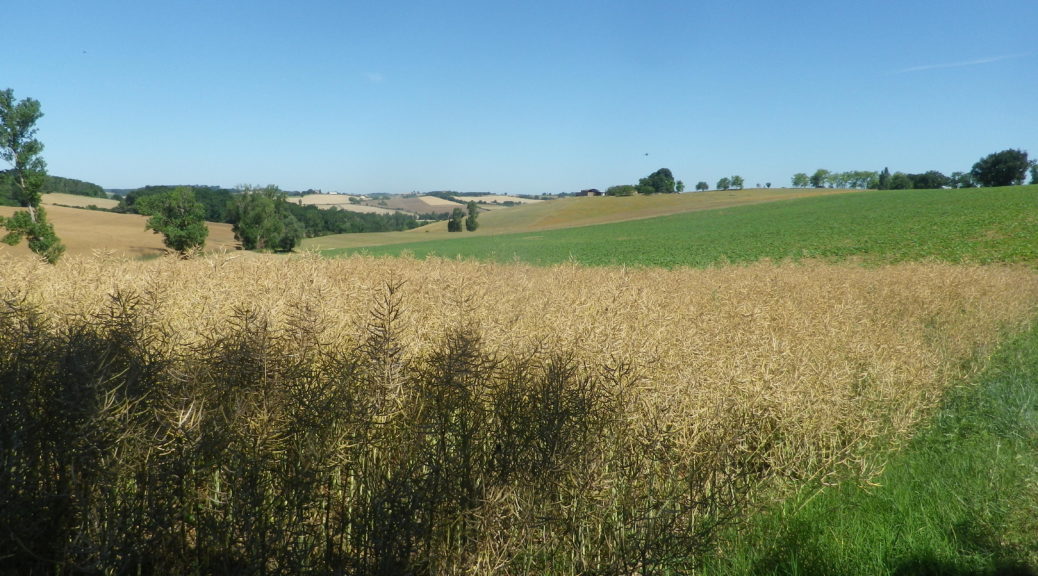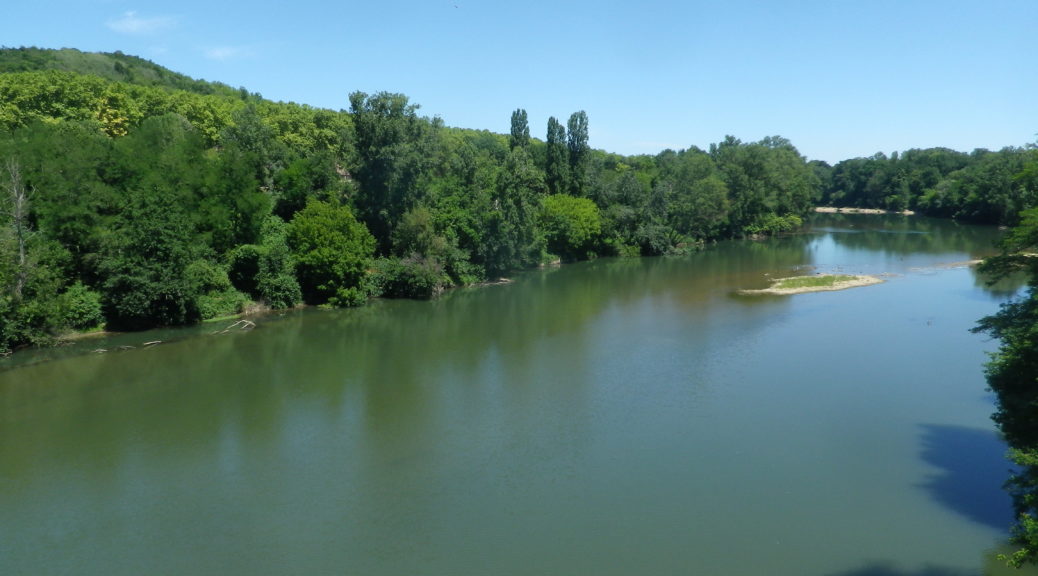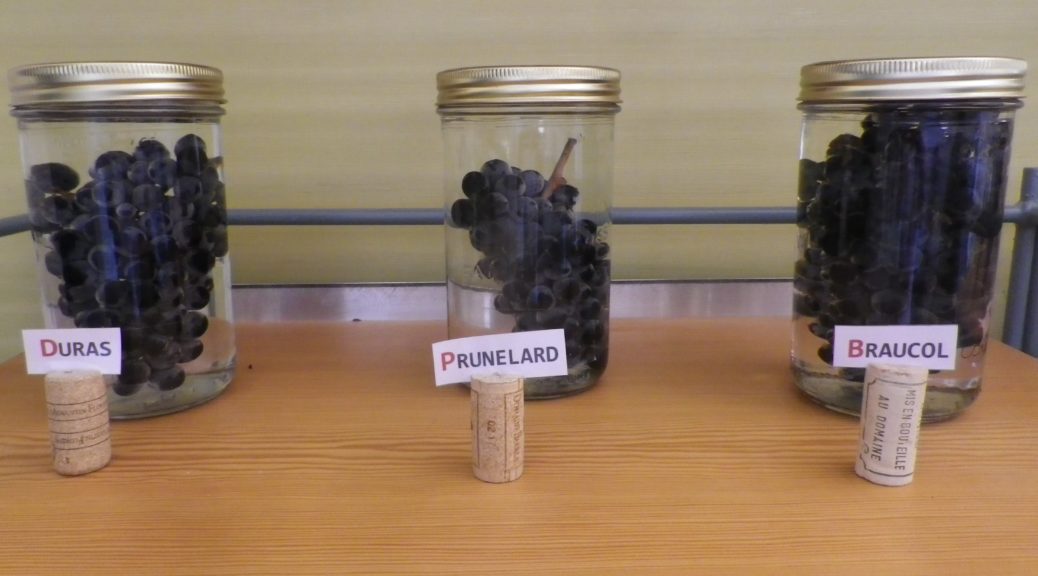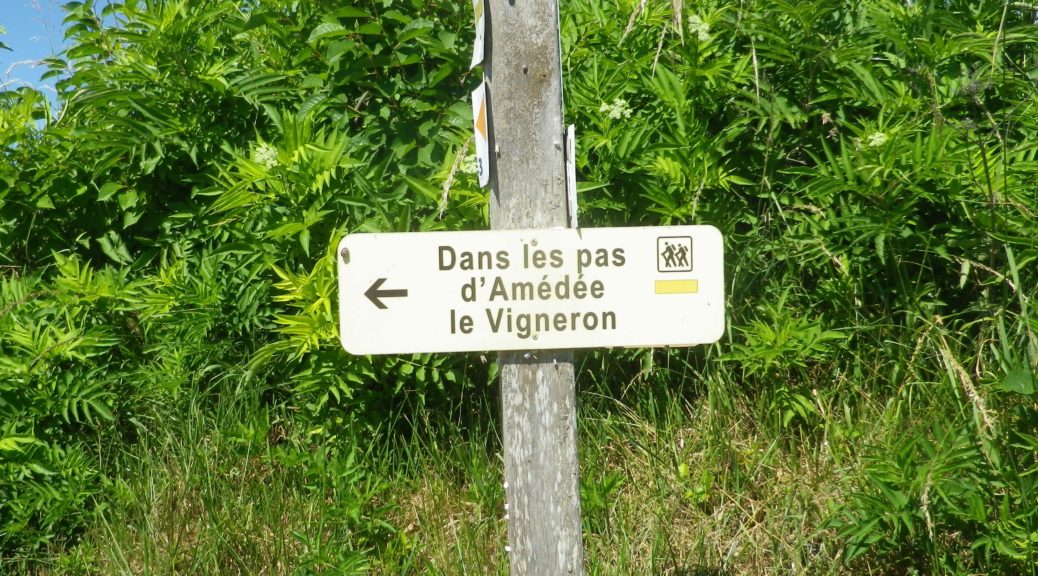Tag Archives: Occitanie
Ramblings in Rabastens
Rabastens, and the Gaillac wine region that it forms a part of, is an unexpected delight. My first time in this southwestern wine region, one of France’s oldest, left me charmed. Toulouse is the regional hub, fascinating in its own right, as is nearby Albi. Rabastens, though, in spite of its proximity to both, retains its quiet rural quality. Not that the town wasn’t hopping on a very crowded market day last June! Local fruit and veg, as well as bottles or cases of local wines, from in the Rive Droite district of the Gaillac wine region, were on offer direct from vintners. That, of course, is why I was there.
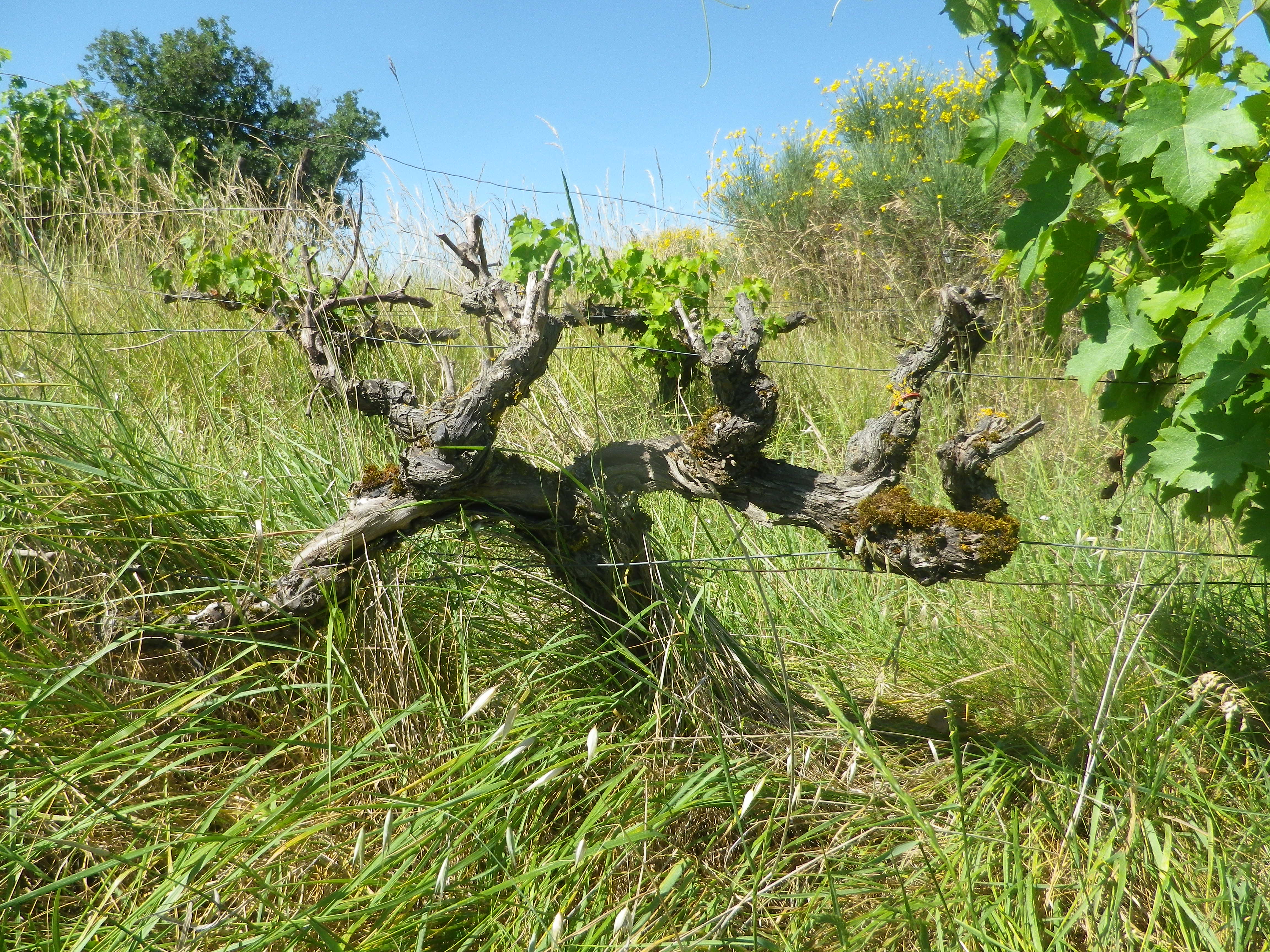
The trail I rambled (hike is an overly energetic word for this easy, short itinerary), began on the outskirts of town, at the local wine cooperative. Fortunately, given the crowds at the market, I found plenty of parking options on that end of town. Like the cooperative, this trail focused on vintners and their wines: Amedee, being a former vintner. Shortly after parking, I (and Marco, my hiking buddy for this trip), were passing along vines, enjoying the song of the birds and the buzz of cicadas, brought out by the heat.
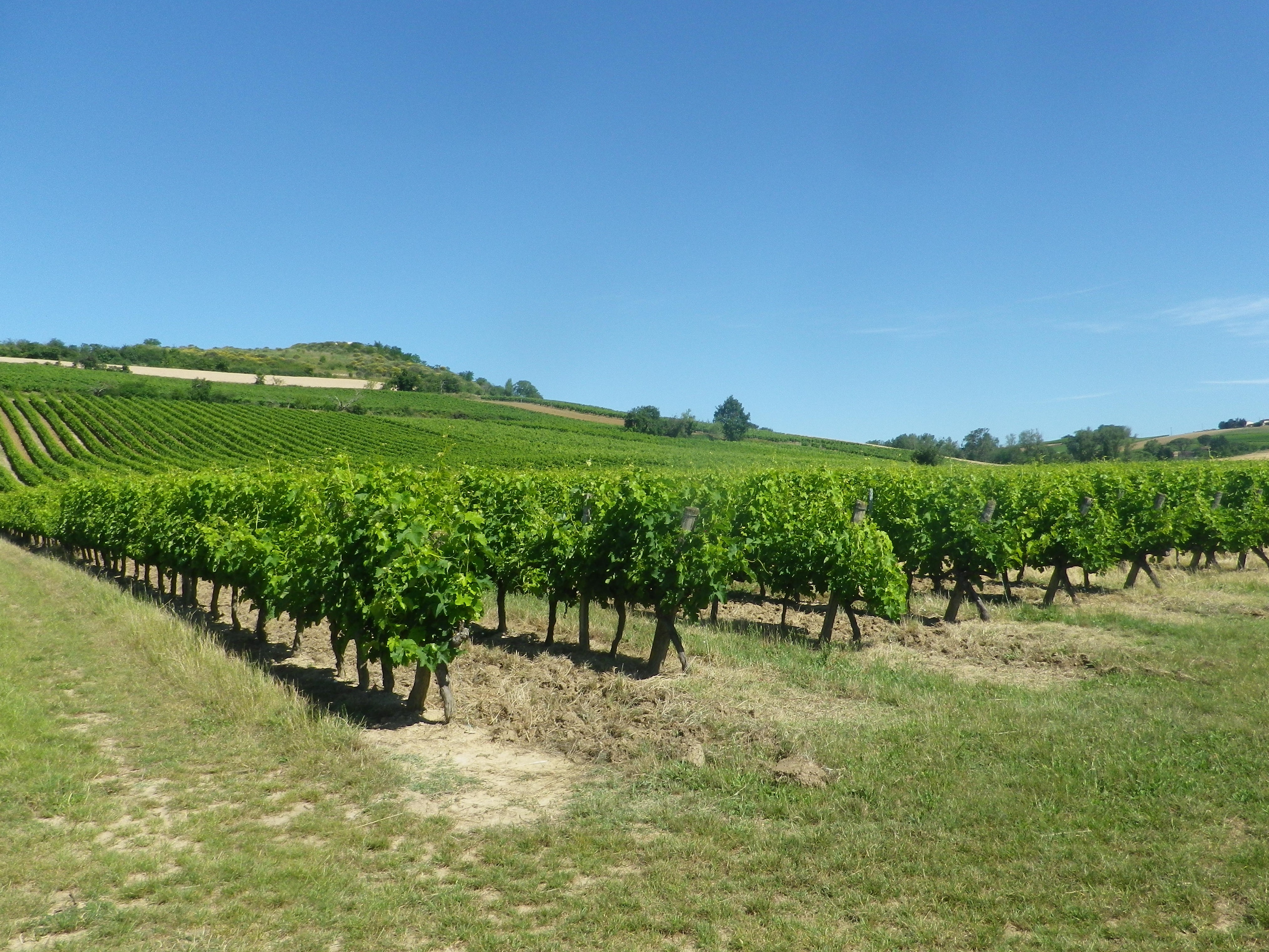
Making a turn uphill, we followed a grassy trail devoid of vines on one side. Instead, splashes of color from myriad wild flowers, all in full bloom that day, popped out against the grasses. The variety of flowers and their abundance were amazing. Focused on photographing the flowers, (and Marco, a hunter, on wildlife tracks) we had little notice of much else. It wasn’t until near the top of the hill that we turned to admire the rest of the scenery.
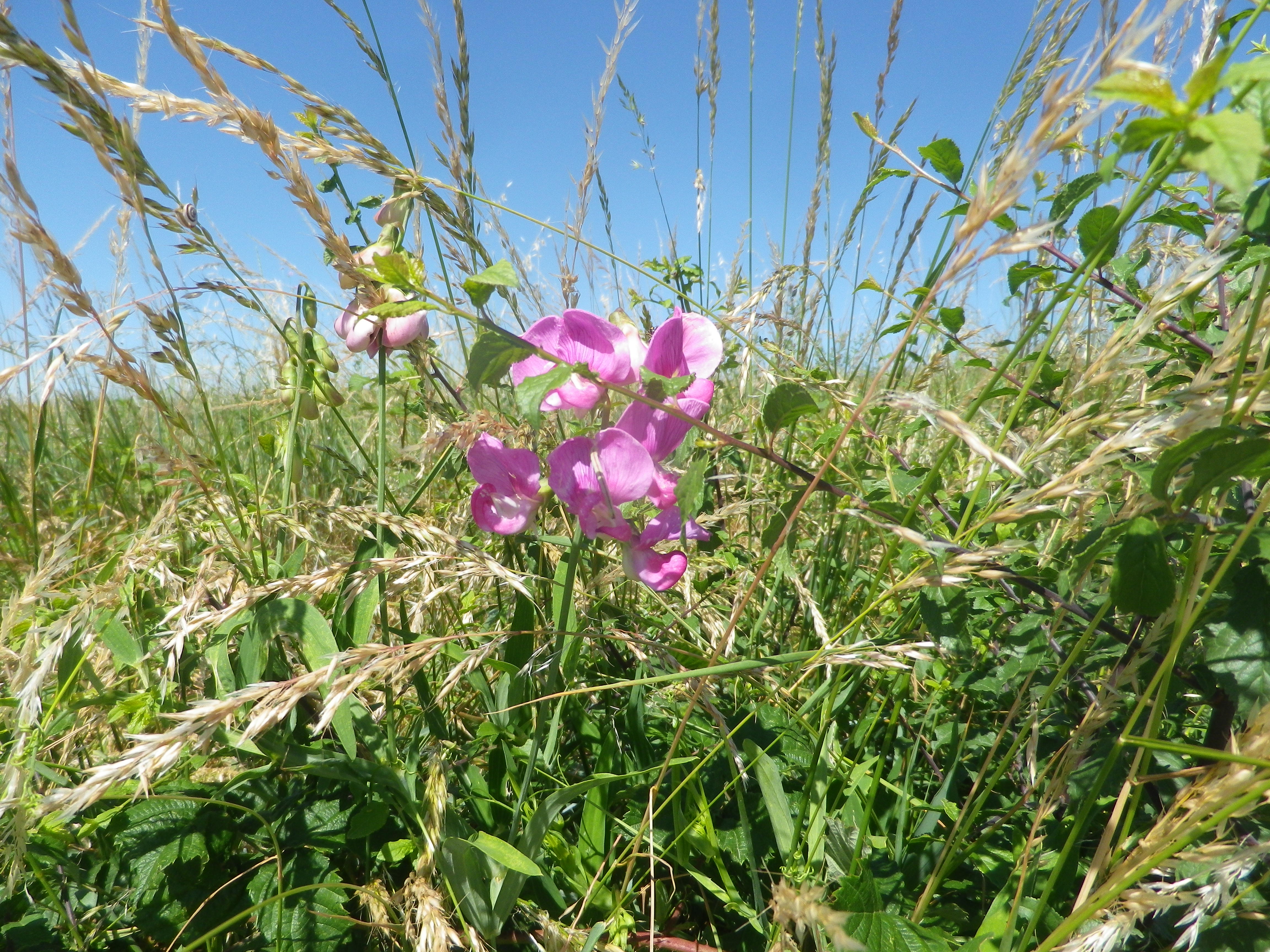
There, to the south, were snow-capped Pyrenees! They didn’t photograph well, due to haze. Haze likely caused by the multitude of rivers that pass between the trail in Rabastens and the mountains. Rabastens lies along the Tarn, which with the Hers and Ariege flow into the Garonne not far to the west, making this area a real watershed. Additionally, it is easy to see why grapes do well here: gentle ridges rise and fall from here to the mountains, and the south-facing slopes are great for vine-planting.
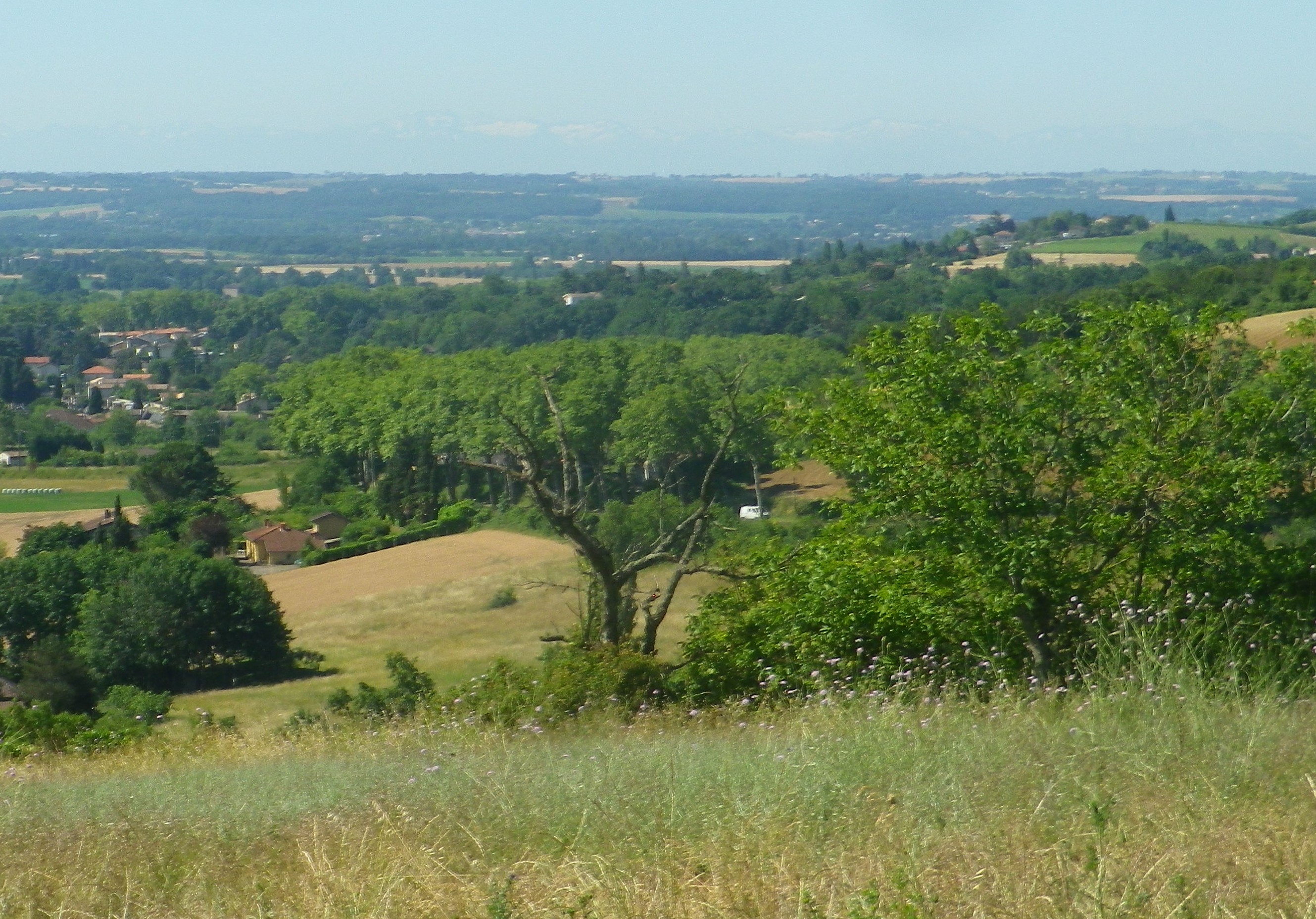
Once on top, the trail turned almost 180 degrees, and headed downhill, through a little draw created by a break in the ridgeline. A stable, then finally an old farm house appeared. After a few more meters, a dovecote appeared. These famed dovecotes, some hundreds of years old and lovingly maintained, show an amazing breadth of style and architecture! Centuries ago, vintners used pigeon droppings to ameliorate the soil around the vines. We walked under a canopy of trees, enjoying the architecture and a respite from sun. In no time, we’d returned to the cooperative for a wine-tasting, and Rabastens, for a well-earned lunch!
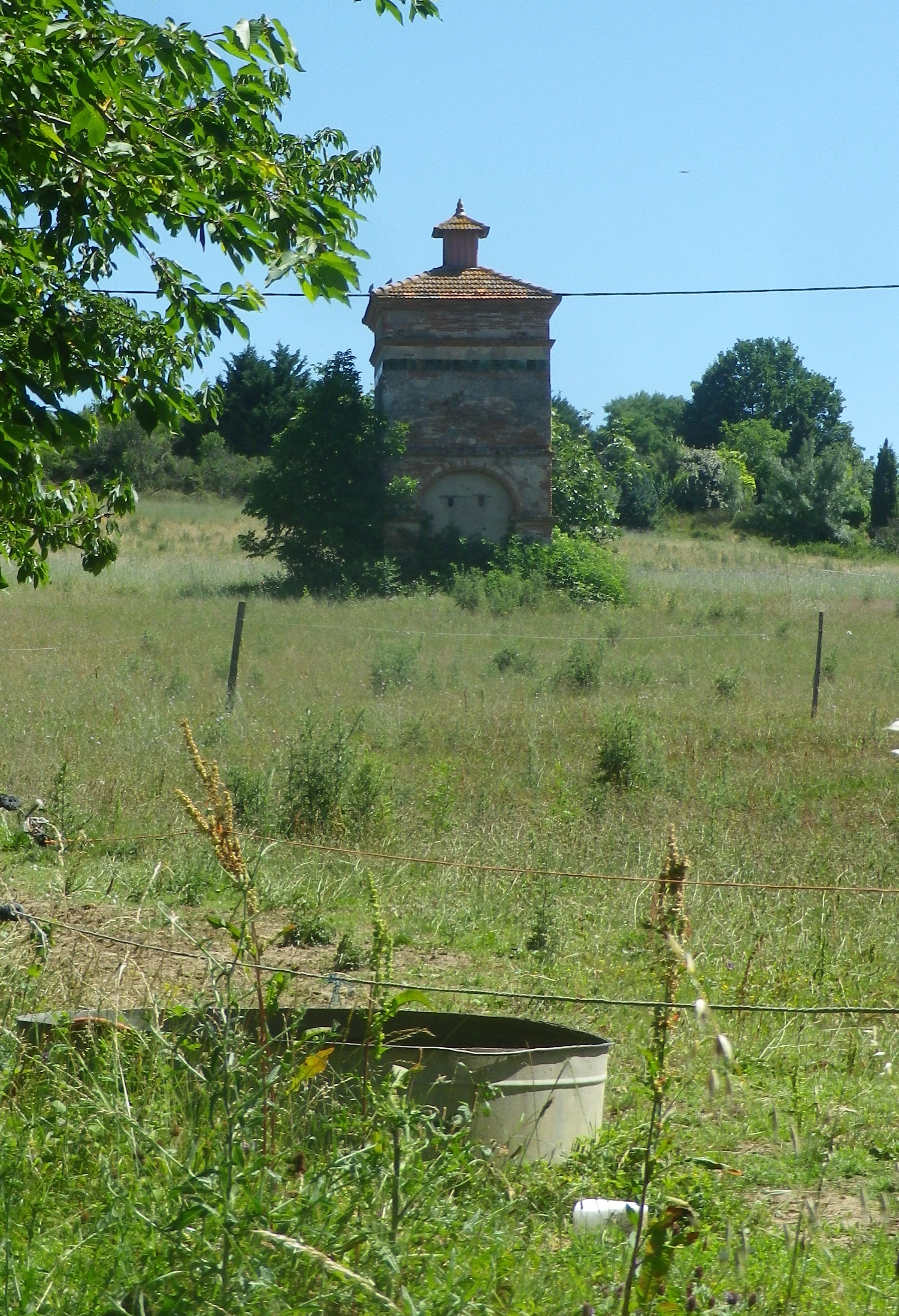
Wine Notes: Gaillac
What I Learned
The Gaillac tradition of wine-making is one of the oldest in France. But well before that, there is documented evidence of the local population drinking wine imported from Greece, and even Asia Minor. Suffice it to say, wine produced here today has a lot of savoir-faire, or know-how, behind it !
The Appellation Gaillac territory lies east of Toulouse, and is subject to both Atlantic and Mediterranean climatic influences. Situated in the rolling hills between the Aveyron River, and both banks of the Tarn River, this fertile area has ideal conditions for vineyards. There are three main growth areas
-The Rive Gauche, known also as the Terrasses de la Rive Gauche, which indicates a generally flatter area
-The Rive Droite (around Gaillac, Lisle sur Tarn and Rabastens), known also, and appropriately so, as Coteaux de la Rive Droite, indicating an area of hills, where vines grow on the south-facing slopes
-The Plateau Cordais, north of the Rive Droit, in an area of higher elevation, which includes the impressive town of Cordes sur Ciel
The dry white wines received appellation status in 1938. Gaillac white wines include some unique varietals such as Loin de l’œil. It is rather perfumed, and is often blended with another unusual varietal Mauzac. Ondenc is yet another appellation varietal, and unusually, it is often harvested and bottled as a later harvest wine.
The red wines, however, only obtained appellation status in 1970. The main red varietal is Braucol, with notes of raspberry and cassis. Duras and Prunelart, both of which were practically extinct by the end of the phylloxera crisis, are usually blended with Braucol, or the another main red varietal in this area, Syrah.
What I Tasted
2021 Loin de l’Oeil, Appellation d’Origine Protegee (AOP) Gaillac, Vinovalie (Saint Sulpice): A dry white wine with very pale, almost white gold color, with a citrus and tropical fruits nose, and citrus and mineral flavors; fairly well-balanced with medium plus acidity
2021 Le Perle, Appellation d’Origine Protegee (AOP) Gaillac, Vinovalie: A dry white cuvee with pale, white gold color; a peach and mineral nose; flavors of green apple, peach, and pineapple; a slight fizz, with mild acidity.
2021 Le Perle, Appellation d’Origine Protegee (AOP) Gaillac, Vinovalie: A dry rose cuvee with pale rose color; red berry nose and flavors, with hints of spice
2020 Loin de l’Oeil, Sans Culotte, Appellation d’Origine Protegee (AOP) Gaillac, Vinovalie (Saint Sulpice): A dry white wine with very pale, almost white gold color; floral nose, with floral and white stone fruits flavors, well balanced with medium acidity, and no sulfites added!
2021 Cuvee, AOP Gaillac, Domaine Les Grezels (Gaillac); A dry white wine cuvee (Muscadelle (20%), Loin de l’œil (40%), and Mauzac (40%)), with pale gold color; citrus nose, with flavors of citrus, and ripe pear; very mild acidity.
2021 Rose cuvee, Appellation d’Origine Controlee (AOC) Gaillac, Chateau de Saurs (Lisle s/Tarn): A dry, salmon pink cuvee of Duras and Syrah, red berry fruits, medium acidity and medium length finish.
2021 Les Cedres, Appellation d’Origine Protegee (AOP) Gaillac, Chateau Tauzies, (bottled by Vinovalie): A dry rose cuvee with pale rose color; bright red berries nose, slightly herbal notes, with flavors of the same.
Les Pas d’Amédée le Vigneron: Trail in a Nutshell
Trail Name: Dans les Pas d’Amédée le Vigneron
Trail Type: Short-distance circuit; well-maintained with hard (paved or packed earth) surfaces; marking for this itinerary is pretty good, but not always present.
Length:
Total – 7 kilometers/4.3 miles
Convenient to: Toulouse, Albi, Montauban, or Gaillac, Occitanie, France
Marking:
Signs specific to the trail (see above and below), as well as the ubiquitous French yellow bar markings
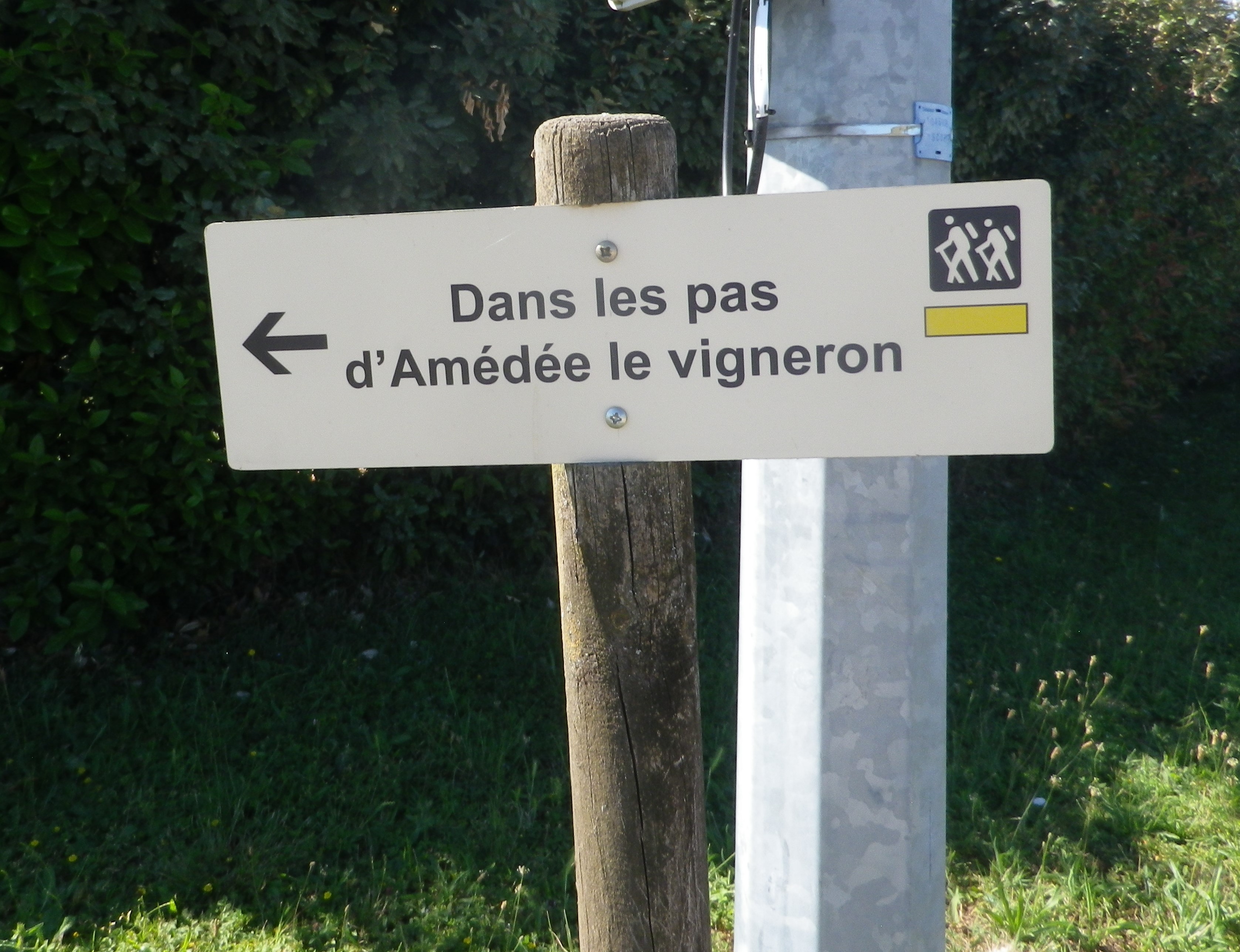
Trail Description: This mostly gentle walk through vineyards and fields in and around Rabastens, a town in the Gaillac wine region, provided lovely views, and several opportunities to sample the wines.
Trailhead:
Official: Rabastens, Vinovalle, Ave de l’Hermitage
Mine : Rabastens, Rue de la Croix Blanche (where the tail leading to the circuit begins)
Parking:
Rabastens: on the shoulder along Avenue de l’Hermitage, and along wider sections of the Chemin de l’Hermitage,
Rabastens: near the school – Ave de la Croix Blanche, (usually full, but empty during school vacations)
Rabastens: Rue des Abreuvoirs, a large central official parking lot, mostly closed during market days, and a kilometer from the trail
Public Transportation Options:
SNCF, the national train system, has a station in Rabastens connecting it with Toulouse and beyond
Suggested Stages:
Not applicable
Trail Itinerary-Reference Points: (Counterclockwise)
Rabastens: Cave, Ave de l’Hermitage, Chemin de l’Hermitage, R. des Ormes, R. des Clarisses, cross Rte de Saurs right to Chemin de la Tremege (Alternatively id’d: Ave de la Croix Blanche), path (La Dressiere) behind school back onto Chemin de la Tremege ; left onto path (250 m before the “t” insection) through vines, onto Las Bordes, stay right at y (350m past plant); sharp turn south/left, Fourtet: almost to Rte 2/Rte de Salvagnac, but just before it, turn left onto narrow Tremege Basse/Cote de la Tremege (by dumpsters); at school, retrace steps to Cave.
Representative Trail Photos:
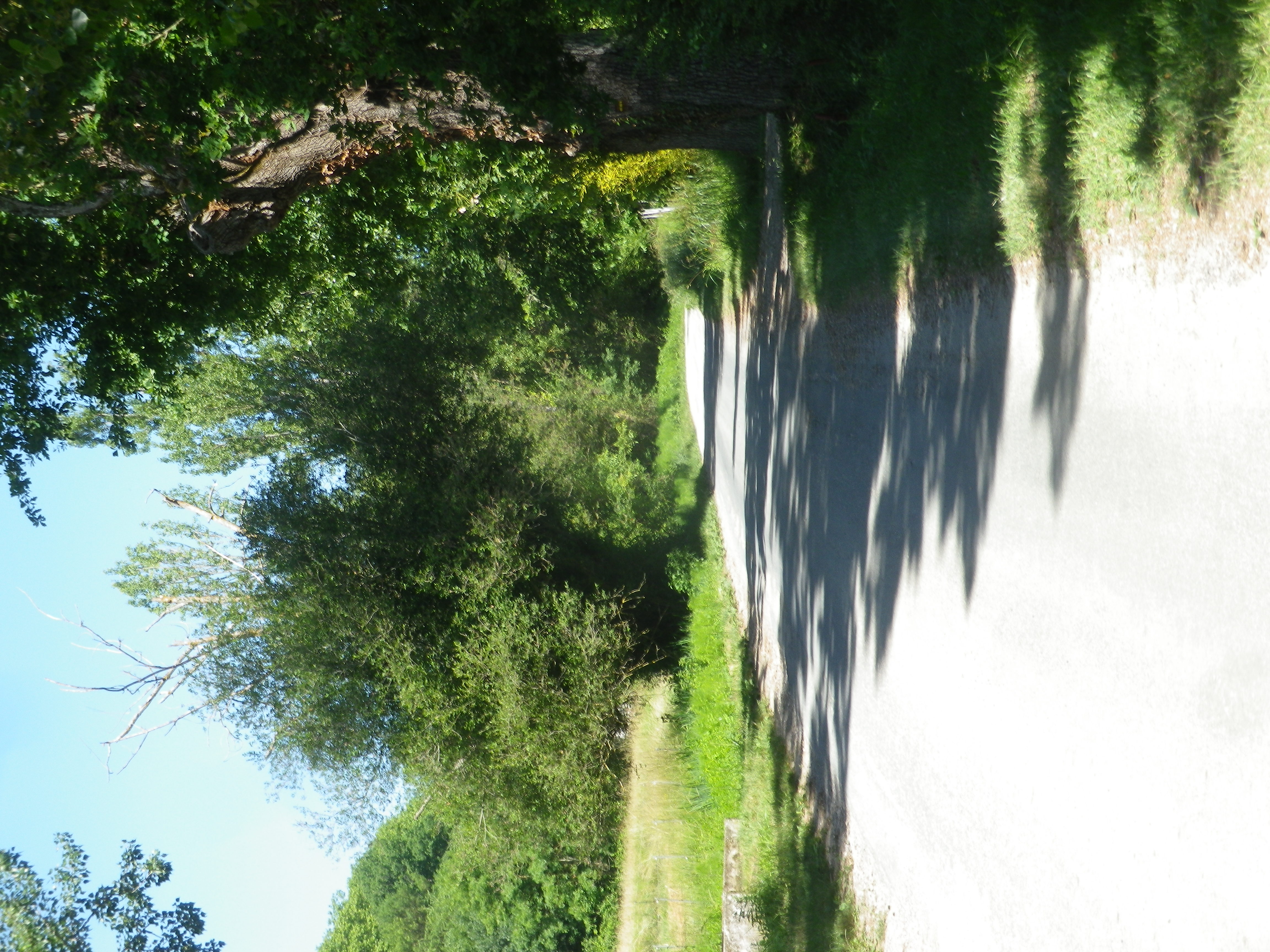
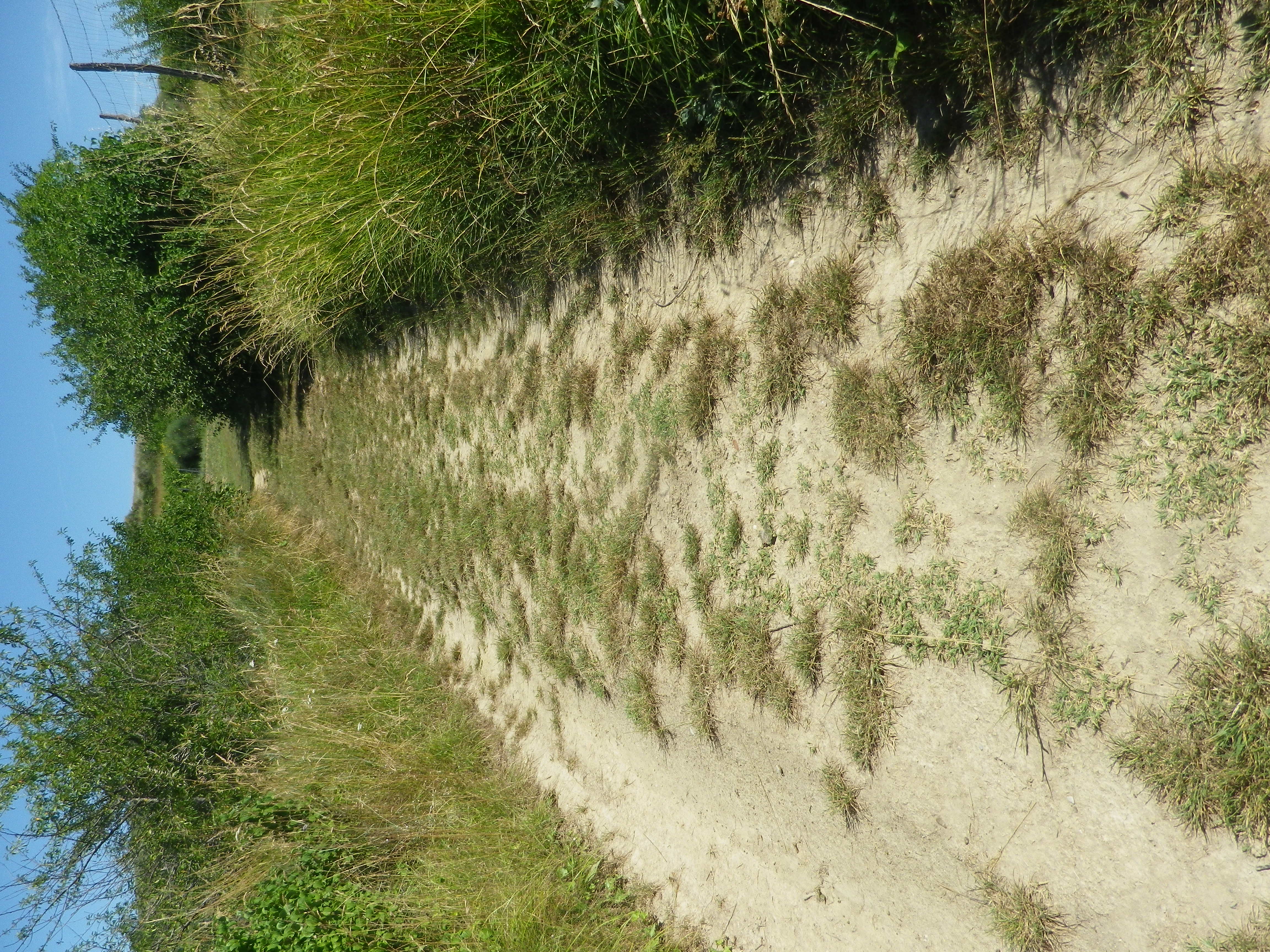
Restrooms:
None observed
Attractions on or near Trail:
(See below)
Tasting along the Trail:
Vinovalle/Vignerons de Rabastens, a local cooperative
Domaine in Ventis, Les Fontaines de Cavalade, both are just off the trail and sell directly at local markets
Alternative Options:
Hiking: Vignes et Clochers, an eight kilometer long circuit trail, starting north of the center of Lisle-sur-Tarn (about five miles northeast of Rabastens), on D18/Camin de Tolze, Alternatively, Lisle-sur-Tarn also has the 11 kilometer Le Vignoble Lislois circuit trail, beginning right on the northern outskirts of the old town
Car: Circuit du Vignoble Gaillacois, Route des Vins de Gaillac, ask local travel offices for help mapping your route
Additional Information:
Regional: https://www.la-toscane-occitane.com/
Trail specific: https://www.france-randos.com/randonnee/rabastens/tarn-81/dans-les-pas-damedee-le-vigneron
Comments:
A very easy walk in a quiet corner of rural France, albeit only 30 kilometers from Toulouse!
